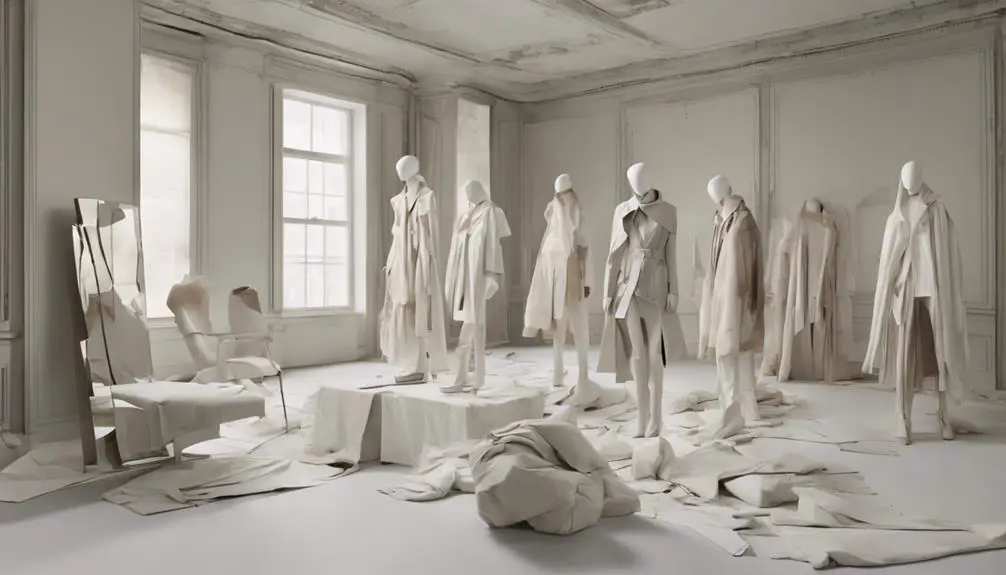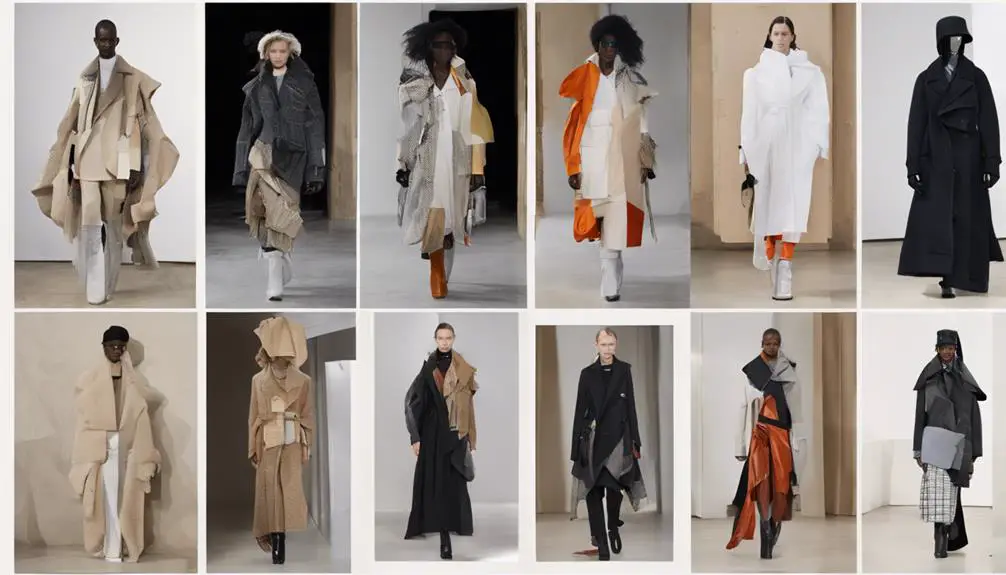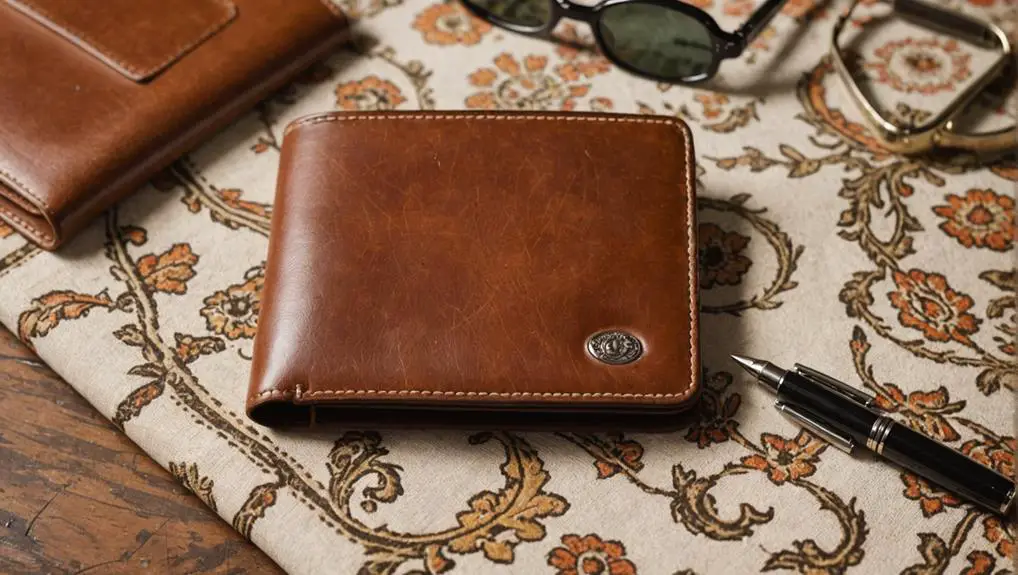Maison Margiela's greatest designs fuse deconstruction and creativity, igniting the fashion world. Iconic pieces like the Porcelain Waistcoat and Graffitied Tabi Boots challenge traditional aesthetics and highlight craftsmanship. The Replica Collection embraces storytelling through vintage reimaginings, while the Artisanal Collection promotes sustainability with upcycled materials. Margiela's work inspires contemporary designers, emphasizing imperfection and individuality. Collaborations, like the one with H&M, make high fashion more accessible, showcasing the brand's innovative spirit. With a legacy of pushing boundaries, Margiela continues to influence future designers. If you're curious about the brand's lasting impact, there's much more to explore.
Martin Margiela's Design Philosophy

Martin Margiela's design philosophy revolves around five key principles that challenge traditional fashion norms. At the core of his approach is deconstruction. You'll notice that Margiela often takes garments apart, reconstructing them to highlight raw materials and craftsmanship. This technique not only showcases the beauty of the materials but also invites you to appreciate the artistry behind each piece.
Upcycling is another significant aspect of Margiela's philosophy. In his Artisanal Collection, he cleverly repurposes materials, promoting sustainability while fostering individuality. By breathing new life into discarded items, he encourages you to view fashion through a different lens, one that values creativity over consumerism.
Playfulness is integral to Margiela's work, too. His designs often incorporate unexpected elements that challenge conventional expectations. Take, for example, the graffitied Tabi Boots. These boots not only redefine footwear but also inject humor and whimsy into the fashion conversation.
Margiela's collections feature a unique labeling system, using blank white tags and numbers instead of names, which reinforces the idea that it's the garment itself that matters most, not the designer's identity.
Through deconstruction, upcycling, and playfulness, Margiela invites you to explore fashion in a new way. His philosophy encourages you to embrace creativity and sustainability, transforming the way you think about what you wear. This invigorating perspective not only reshapes your wardrobe but also influences the broader fashion landscape.
Iconic Pieces and Collections
At the heart of Maison Margiela's legacy lies a collection of iconic pieces that redefine fashion through innovation and artistry. Each design tells a story, capturing the essence of Margiela's unique vision.
Take the Porcelain Waistcoat, for instance. Created in A/W89, it showcases a deconstructionist approach, turning shattered porcelain into a striking art piece that challenges the norms of fashion.
Then there are the Graffitied Tabi Boots, introduced in 1991. With their split-toe design, they've become a contemporary classic, symbolizing Margiela's avant-garde aesthetic. These boots brilliantly repurpose earlier designs, emphasizing the brand's knack for innovation.
The Replica Collection from 1994 is another standout, reimagining vintage garments and inviting wearers into a narrative of fashion as storytelling. Each piece in this collection represents a specific historical moment, blending authenticity with style.
In 2002, the Artisanal Collection emerged, showcasing unique handcrafted pieces made from upcycled materials. This collection reflects Margiela's commitment to sustainability and the artistry of individual craftsmanship, making each item special.
Impact on Contemporary Fashion

Maison Margiela's iconic pieces haven't only defined the brand's identity but also left a lasting mark on the landscape of contemporary fashion. As a fashion designer, Martin Margiela's pioneering deconstructionist approach encouraged you to embrace imperfections and rethink traditional garment construction. This shift has inspired many contemporary designers to experiment with their own styles, leading to a more diverse fashion scene.
His work parallels that of other influential designers, like Gianni Versace, who also revolutionized fashion with distinct aesthetics and branding historical tag evolution.
One of Margiela's most notable contributions is the Tabi boots, which blurred the lines between high fashion and everyday wear. These unique shoes have become a staple in modern luxury footwear collections, showing how bold designs can influence mainstream fashion.
Furthermore, Margiela's commitment to upcycling and using unconventional materials laid the groundwork for sustainable fashion practices, motivating a new generation of designers to prioritize eco-friendly methods.
Additionally, Margiela's innovative presentation styles—like immersive shows in unconventional venues—have transformed how fashion is showcased. This has encouraged designers to create engaging experiences for their audiences, making fashion more accessible and exciting.
You can see the impact of Margiela's ethos in the work of designers like Demna Gvasalia and Marc Jacobs, who blend avant-garde aesthetics with wearability.
Collaborations and Creative Partnerships
Collaborations and creative partnerships have played a pivotal role in shaping the identity of Maison Margiela. By teaming up with various brands and artists, Margiela has pushed boundaries and brought avant-garde fashion into the mainstream. One landmark collaboration was with H&M in 2012, where Margiela's distinctive style reached a broader audience, making high fashion more accessible.
In the early 2000s, the partnership with Hermès showcased his unique craftsmanship, blending high fashion with conceptual elements. These collaborations not only highlighted his innovative design philosophy but also reinforced the idea that luxury can coexist with creativity.
Sustainability has also been a priority in Margiela's collaborations. The Artisanal Collection, featuring handcrafted pieces made from upcycled materials, demonstrated his commitment to ethical fashion. This focus on sustainability reflects a growing trend in the industry, showing that style can be both chic and responsible.
Moreover, Margiela's artistic partnerships have enriched his brand's narrative. When John Galliano became Creative Director in 2014, he infused his opulent style into Margiela's deconstructionist roots, creating a blend that captivated fashion enthusiasts.
Through these collaborations and creative partnerships, Maison Margiela has continued to inspire contemporary designers, including Demna Gvasalia of Vetements, who credits Margiela as a significant influence.
Altogether, these alliances not only showcase Margiela's genius but also highlight the importance of collaboration in fostering innovation within the fashion world.
Legacy and Future Directions

Since its inception, Maison Margiela has carved out a legacy that's deeply rooted in the concepts of deconstruction and upcycling, influencing contemporary fashion practices and sustainable design philosophies.
The brand continues to evolve, particularly under John Galliano's creative direction, blending opulence with avant-garde aesthetics. This guarantees it remains relevant in an ever-changing fashion landscape.
Looking ahead, you can expect Maison Margiela to shape the future of fashion through several key areas:
- Sustainable Practices: The brand's commitment to upcycling will likely inspire more designers to embrace sustainable materials and methods.
- Avant-Garde Innovations: Margiela's unconventional use of materials, like transparent plastics, sets a bold precedent that challenges traditional fashion norms.
- Cultural Dialogue: Each collection will probably continue to reflect a conversation between historical references and modern sensibilities, maintaining the brand's unique narrative.
- Diverse Appeal: As it resonates with various clientele—from celebrities to fashion enthusiasts—Maison Margiela's ability to blend art with wearability will keep it in the spotlight.



